Customer Journey Mapping for GTM: Strategic Insights for B2B Success
Did you know that 84% of B2B buyers say the key to winning their business is treating them like a human, not just another sales target? Customer journey mapping has emerged as the strategic compass helping market research professionals decode exactly how to do that.
Market research and customer insights teams are constantly wrestling with a critical challenge: understanding the complex, multi-touchpoint experiences that drive B2B purchase decisions. Traditional research methods often fall short, leaving organizations with fragmented insights that fail to capture the nuanced interactions between potential clients and their solutions.
The result is a persistent gap between what companies think their customers want and the actual strategic needs driving purchase behaviors. Without a comprehensive, data-driven approach to customer journey mapping, go-to-market strategies become shots in the dark—expensive, inefficient, and increasingly disconnected from real-world customer expectations.
Understanding the Basics of Customer Journey Mapping
At its core, customer journey mapping is a strategic visualization that traces every interaction and touchpoint a potential B2B client experiences from initial awareness to final purchase and beyond. Think of it as a detailed roadmap that reveals the intricate paths, emotional responses, and decision-making moments that influence how businesses select and engage with solution providers.
This methodical approach goes far beyond traditional sales funnel thinking. Customer journey mapping captures the holistic experience, documenting not just linear progression but the complex ecosystem of interactions, pain points, and motivational triggers that drive B2B purchasing decisions.
Key Components of an Effective Customer Journey Map
- Persona Development: Creating detailed representations of ideal customer segments
- Touchpoint Identification: Mapping every potential interaction across marketing, sales, and support channels
- Emotional Insight Tracking: Understanding psychological drivers behind decision-making
- Gap Analysis: Identifying disconnections between customer expectations and current service delivery
The strategic value of customer journey mapping lies in its ability to transform abstract customer interactions into actionable intelligence. For market research professionals, this means moving beyond surface-level data to uncover deep, nuanced insights that can dramatically reshape go-to-market strategies.
By systematically documenting each stage of the customer's decision-making process, organizations gain unprecedented visibility into the motivations, challenges, and preferences that truly drive B2B purchasing behaviors. This granular understanding becomes a powerful competitive advantage, enabling more precise targeting, personalized engagement, and ultimately, more effective solution development.
Why Customer Journey Mapping Matters for Your Business
For B2B companies navigating increasingly complex market landscapes, customer journey mapping isn't just a strategic tool—it's becoming a critical competitive differentiator. The research is clear: organizations that deeply understand their customer's experience are 60% more profitable than those that don't.
Strategic Business Benefits
-
Enhanced Market Penetration
By precisely understanding customer decision paths, businesses can align their solutions more accurately with actual market needs, reducing time-to-market and increasing conversion rates.
-
Improved Product-Market Fit
Detailed journey mapping reveals hidden customer pain points, enabling more targeted product development and feature prioritization that genuinely solve real-world challenges.
-
Optimized Resource Allocation
Insights from journey mapping help companies invest marketing and sales resources more strategically, focusing on high-impact touchpoints that drive meaningful engagement.
-
Competitive Differentiation
Understanding customer experiences at a granular level allows businesses to create more personalized, empathetic interactions that set them apart from competitors.
Critical Mistakes to Avoid
- Relying on Assumptions: Skipping rigorous research and basing journey maps on internal perceptions instead of actual customer experiences
- Static Mapping: Treating customer journey maps as one-time documents rather than dynamic, continuously evolving resources
- Lack of Cross-Functional Collaboration: Developing journey maps in organizational silos without input from sales, marketing, product, and customer support teams
- Overlooking Emotional Dimensions: Focusing exclusively on transactional interactions while neglecting the psychological and emotional aspects of decision-making
The most successful B2B organizations recognize that customer journey mapping is more than a methodological exercise—it's a strategic lens that transforms how businesses understand, engage, and serve their clients.
A Strategic Framework for Effective Customer Journey Mapping

Transforming customer insights into actionable go-to-market strategies requires a systematic, rigorous approach. This step-by-step framework will guide market research professionals through crafting comprehensive and impactful customer journey maps.
Step 1: Deep Persona Research and Development
Create foundational understanding through multi-dimensional customer persona exploration.
Actionable Actions:
- Conduct qualitative interviews with existing customers
- Analyze demographic and behavioral data from CRM systems
- Map professional roles, pain points, and decision-making motivations
Pro Tips:
- Use a combination of quantitative surveys and qualitative interviews
- Include both current customers and prospects in research pool
- Look beyond job titles to understand individual professional aspirations
Common Pitfalls:
- Relying exclusively on internal assumptions
- Creating overly generic personas
- Neglecting emerging market segments
Step 2: Comprehensive Touchpoint Mapping
Document every potential interaction across the entire customer engagement ecosystem.
Actionable Actions:
- Identify all digital and physical interaction points
- Chronologically sequence customer interactions
- Assign emotional and functional assessments to each touchpoint
Pro Tips:
- Use visual mapping tools for complex journey representations
- Include both external and internal organizational touchpoints
- Consider indirect influence channels like peer recommendations
Common Pitfalls:
- Overlooking subtle interaction moments
- Focusing only on transactional touchpoints
- Ignoring cross-departmental interactions
Step 3: Emotional and Functional Insight Analysis
Uncover the psychological drivers underlying customer decision-making processes.
Actionable Actions:
- Develop sentiment scoring for each journey stage
- Identify emotional triggers and barriers
- Correlate functional needs with emotional responses
Pro Tips:
- Use advanced analytics and machine learning for deeper insights
- Create empathy maps alongside journey maps
- Regularly update emotional insight tracking
Common Pitfalls:
- Treating emotional insights as secondary
- Using one-dimensional emotional assessment
- Failing to connect emotional insights to strategic actions
Essential Tools and Frameworks for Customer Journey Mapping

Implementing a robust customer journey mapping strategy requires more than just theoretical knowledge—it demands the right technological support and strategic frameworks. Market research professionals can leverage specialized tools and established methodologies to transform insights into actionable go-to-market strategies.
Recommended Tools for Customer Journey Mapping
-
Smaply
A dedicated customer journey mapping platform that offers visual storytelling capabilities, allowing teams to create detailed personas, journey maps, and emotional impact tracking with intuitive drag-and-drop interfaces.
-
UXPressia
Combines persona development, journey mapping, and collaborative features that enable cross-functional teams to build comprehensive customer experience visualizations with real-time collaboration options.
-
Salesforce Journey Builder
Enterprise-grade solution that integrates customer journey mapping directly with CRM data, enabling precise tracking of interactions across multiple touchpoints and personalized engagement strategies.
-
Lucidchart
A versatile diagramming tool that supports complex journey mapping with extensive collaboration features, making it easy to create, share, and iterate on customer experience visualizations.
-
Qualtrics CustomerXM
Advanced platform that combines journey mapping with experience management, providing deep analytical insights into customer interactions and emotional drivers.
Strategic Frameworks for Customer Journey Mapping
-
LUMA Journey Mapping Framework
Provides a human-centered design approach that emphasizes empathy and systematic exploration of customer experiences, complementing the emotional insight tracking described in previous steps.
-
McKinsey Customer Decision Journey Model
Offers a comprehensive approach to understanding non-linear customer decision-making processes, particularly valuable for complex B2B purchasing environments.
-
Forrester's Customer Journey Mapping Methodology
Delivers a structured approach to mapping customer interactions, with specific emphasis on identifying moments of friction and opportunity across different engagement stages.
-
Design Thinking Customer Journey Framework
Integrates iterative design principles with customer experience mapping, encouraging continuous refinement and adaptive strategy development.
By combining advanced tools with established frameworks, market research professionals can develop more nuanced, data-driven customer journey maps that translate complex insights into strategic advantages.
Conclusion: Transforming Customer Journey Insights into Strategic GTM Success
Mastering customer journey mapping for go-to-market strategies represents a critical inflection point for B2B technology and services organizations seeking competitive differentiation. By integrating advanced behavioral analytics, cross-functional collaboration, and iterative optimization techniques, market research professionals can transform raw customer data into strategic intelligence that drives precise targeting, enhanced value propositions, and more predictive engagement models. The most successful GTM approaches will leverage journey mapping not merely as a diagnostic tool, but as a dynamic, continuously evolving framework that anticipates customer needs, aligns organizational capabilities, and creates measurable competitive advantages in increasingly complex technological ecosystems.
